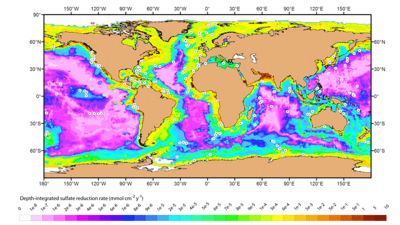Page path:
- Home
- Discover
- Media Releases
- Media Releases 2014
- Sulfate-starved microbes rule the deep biosphere
Sulfate-starved microbes rule the deep biosphere
Sulfate is an inorganic sulfur compound that occurs in all natural waters. A group of so called sulfate reducing microorganisms use sulfate for the oxidation of organic matter under anoxic conditions and obtain energy by “breathing” it. The activity of sulfate reducers is often identified by the characteristic smell of rotten eggs, which comes from its by-product hydrogen sulfide. Sulfate reducers generate most of the naturally-occurring hydrogen sulfide worldwide. In the sea floor this microbial process is ubiquitous and an important link between the cycles of sulfur and carbon. Sulfate reduction is also considered to be an essential energy source for microbial life in the deep biosphere.
The amount of sulfate that is converted annually by microorganisms in the sea floor is difficult to estimate on a global scale, because the turnover rates vary strongly according to the marine environment. Previous estimations are rather coarse and do not include the spatial differences. “The goal of our study was to integrate these spatial differences in our calculations to get realistic values for the global rates of microbial sulfate reduction”, explains MARUM scientist Dr. Marshall Bowles. Together with his colleague Dr. José
Mogollón, formerly at the Alfred Wegener Institute (AWI), now working at the University of Utrecht, he and a team of scientists developed an artificial neural network that predicts sulfate reduction rates according to the local chemical and physical conditions, thus capturing various regional heterogeneities across the globe. The model was based on a vast accumulation of data collected over more than four decades by the international drilling programs Deep Sea Drilling Project (DSDP), Ocean Drilling Program (ODP) and International Ocean Discovery Program (IODP).
The team estimates that globally one giga-ton of sulfate is reduced yearly, about 15 percent of the previous estimates. “Most studies measuring sulfate reduction have been performed in highly-productive, muddy sediments, and have thus largely ignored the sandy areas where the organic carbon content and the sulfate reduction rates are lower“, says Mogollón. “This bias translated directly into the previous global estimates of sulfate reduction.“ This new estimate of global sulfate reduction aligns better with independent estimations of the accumulation rates of organic carbon in oceanic sediments. Beside the two main authors, AWI scientist Dr. Sabine Kasten and MARUM scientists Dr. Matthias Zabel and Professor Kai-Uwe Hinrichs contributed to this study.
The combination of their findings on sulfate consumption with data on the global distribution of microorganisms in oceanic sediments also allowed the researchers to give implications for subseafloor microbial communities and their activity. The concentration of sulfate in the sediment decreases with depth, and this strongly influences the composition of and processes performed by the local microbial communities. Based on the modeled results, the team of researchers could predict that globally approximately 50 percent of all microbial cells live in deep layers where sulfate reduction no longer occurs, whereas at the continental margins this fraction is about 90 percent.
Publication:
Global rates of marine sulfate reduction and implications for subseafloor metabolic activities
Marshall W. Bowles, José M. Mogollón, Sabine Kasten, Matthias Zabel, Kai-Uwe Hinrichs
Published in: Science (online 8th Mai 2014) DOI: 10.1126/science.1249213
More information / interview requests / photos:
Jana Stone
MARUM Science Communication
Phone ++49 - 421 - 218-65541
E-mail: [Bitte aktivieren Sie Javascript]
The amount of sulfate that is converted annually by microorganisms in the sea floor is difficult to estimate on a global scale, because the turnover rates vary strongly according to the marine environment. Previous estimations are rather coarse and do not include the spatial differences. “The goal of our study was to integrate these spatial differences in our calculations to get realistic values for the global rates of microbial sulfate reduction”, explains MARUM scientist Dr. Marshall Bowles. Together with his colleague Dr. José
Mogollón, formerly at the Alfred Wegener Institute (AWI), now working at the University of Utrecht, he and a team of scientists developed an artificial neural network that predicts sulfate reduction rates according to the local chemical and physical conditions, thus capturing various regional heterogeneities across the globe. The model was based on a vast accumulation of data collected over more than four decades by the international drilling programs Deep Sea Drilling Project (DSDP), Ocean Drilling Program (ODP) and International Ocean Discovery Program (IODP).
The team estimates that globally one giga-ton of sulfate is reduced yearly, about 15 percent of the previous estimates. “Most studies measuring sulfate reduction have been performed in highly-productive, muddy sediments, and have thus largely ignored the sandy areas where the organic carbon content and the sulfate reduction rates are lower“, says Mogollón. “This bias translated directly into the previous global estimates of sulfate reduction.“ This new estimate of global sulfate reduction aligns better with independent estimations of the accumulation rates of organic carbon in oceanic sediments. Beside the two main authors, AWI scientist Dr. Sabine Kasten and MARUM scientists Dr. Matthias Zabel and Professor Kai-Uwe Hinrichs contributed to this study.
The combination of their findings on sulfate consumption with data on the global distribution of microorganisms in oceanic sediments also allowed the researchers to give implications for subseafloor microbial communities and their activity. The concentration of sulfate in the sediment decreases with depth, and this strongly influences the composition of and processes performed by the local microbial communities. Based on the modeled results, the team of researchers could predict that globally approximately 50 percent of all microbial cells live in deep layers where sulfate reduction no longer occurs, whereas at the continental margins this fraction is about 90 percent.
Publication:
Global rates of marine sulfate reduction and implications for subseafloor metabolic activities
Marshall W. Bowles, José M. Mogollón, Sabine Kasten, Matthias Zabel, Kai-Uwe Hinrichs
Published in: Science (online 8th Mai 2014) DOI: 10.1126/science.1249213
More information / interview requests / photos:
Jana Stone
MARUM Science Communication
Phone ++49 - 421 - 218-65541
E-mail: [Bitte aktivieren Sie Javascript]



